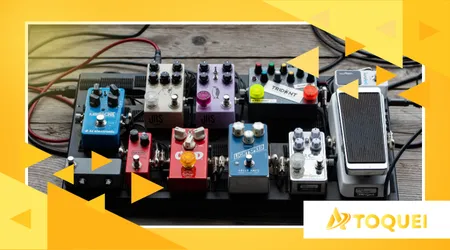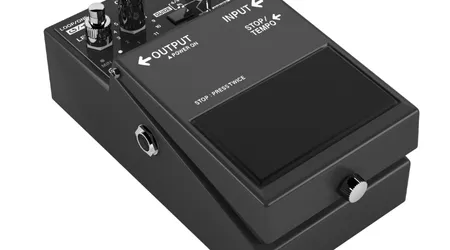Is it worth buying a pedal board or separate pedals?

The eternal doubt that haunts guitarists and bassists: when assembling the rig, it's more worth it buy pedalboard or pedals separately? The answer, in 2025, goes far beyond cost-benefit.
Advertisements
It involves philosophy, practicality, and, of course, the relentless pursuit of the perfect tone. The effects market has evolved dramatically, offering incredible options on both fronts.
The Seductive Promise of the Multi-Effects Pedalboard
Modern pedalboards are veritable command centers. They offer hundreds of amp and effects simulations. They're a complete, all-in-one solution for the contemporary musician.
Convenience is an undeniable advantage. Taking it to a show or rehearsal is much easier. Fewer cables and power supplies mean less chance of failure at the crucial moment.
Modeling technology, or modeling, has reached impressive levels of realism. Brands like Line 6, Boss, and Headrush are leading this digital revolution.
Advertisements
This equipment is ideal for those who play a variety of styles. Easy to save and access presets is a blessing for versatile musicians.
They represent the gateway to a universe of sonic possibilities. You don't need buy pedalboard or pedals separately to have a wide tonal palette.
Read more: Compilations, reissues or remasters: what's the difference and why do they matter in music?
The Financial Factor and Continuous Updating
Financially, a pedalboard is usually more cost-effective. Buying 10 or 15 pedals boutique separately requires a greater investment.
Many come with built-in audio interfaces, facilitating recording in home studios. This feature adds enormous value to musicians and producers.
Manufacturers frequently release updates firmwareThis guarantees new amplifier and effects models for free.
A single USB cable provides the connection to the computer. Convenience is a strong selling point for those who live on the road or in small apartments.

The Unparalleled Charm and Flexibility of Single Pedals
On the other hand, separate pedals, or stompboxes, continue to have a legion of fans. They offer a unique tactile and audible experience.
There's an undeniable charm to the act of "pressing" an analog pedal. The sensation underfoot and the light that comes on inspire many instrumentalists.
The main advantage is the total freedom of choice. The musician selects each component of his rig in a thorough manner.
He can mix a overdrive vintage tube amp with a delay modern digital, for example. This results in combinations that are impossible on closed pedalboards.
++ Top 5 Headphones for Musicians Practicing at Home
Author's Stamp: The Power of Personalization
Analog pedals, such as fuzzes and distortions, offer a distinct dynamic response. Many purists consider these tones unsurpassed by digital modeling.
The customization of signal chain is the trump card. The musician defines the exact order of the effects. This drastically influences the final sound.
Imagine that guitarist Mark Tremonti, known for his full-bodied tone, opted for separate pedals. He's looking for that heavy, unmistakable sound.
Its sound is the result of a specific and carefully crafted combination of pedals. This is the essence of the "signature tone" that many musicians strive for.
A practical example is the ease of repair or replacement. If a pedal chorus break, only it is replaced, not the entire equipment.
++ Digital piano reviews for beginners
| Feature | Multi-Effects Pedalboard | Individual Pedals |
| Versatility | High (Multiple sounds saved) | Medium (Limited to number of pedals) |
| Initial Cost | Lower (Cost per effect) | Bigger (Each pedal is an investment) |
| Tone Quality | Excellent (Top modeling) | Supreme (Many purists prefer analog) |
| Settings | Simple (Plug and play) | Complex (Cables, sources, order) |
| Size/Weight | Compact/Lightweight | Big/Heavy (With lots of pedals) |
The Smart Choice in 2025: Hybrid and Convergence
In 2025, the debate is no longer about black or white. Many musicians are embracing hybrid approach. They use a high-end pedalboard with some stompboxes specials.
This combination takes advantage of the best of both worlds. The pedalboard takes care of the modulating effects, reverbs and delays in a practical way.
++ After all, which investment is more worthwhile: pedals or pedalboard?
Individual pedals are used to drives and fuzzesThis is where the analog sound makes all the difference for the musician.
Research released by NAMM (National Association of Music Merchants) in 2024 reveals: “Over 65% of professional musicians interviewees use a hybrid configuration of effects.”
This demonstrates a clear market trend toward adaptability. The rigidity of choosing just one format is falling into disuse.
Chef Analogy
The choice between the two formats is like a chef's decision. He can buy a state-of-the-art food processor (pedalboard).
Or, alternatively, he may choose to purchase separate knives, blenders and mixers of specific brands and models (pedals).
Both approaches produce fantastic dishes. But the second offers surgical control over the texture and seasoning of each component.
The decision to buy pedalboard or pedals separately reflects your level of control. How much control do you need and how deep do you want to go in your quest for tone?
After all, in the pursuit of artistic expression, wouldn't it be foolish to limit yourself to a single tool? The freedom to experiment is the key to creativity.
Conclusion: Your Sound, Your Rules
For beginners who need a lot of sounds on a tight budget, a pedalboard is the most sensible option. It allows you to experiment without spending a lot.
For the experienced musician seeking a unique sound signature, the customization of separate pedals is unbeatable. This option is more expensive, but it offers a unique tone.
The important thing is to understand your needs. If you're looking for versatility, go with a pedalboard. If you're looking for extreme customization, assembling individual pedals is the way to go.
Remember: in 2025, the best answer to buy pedalboard or pedals separately is the one that inspires you to play more and better. Equipment is a means, never the end.
Frequently Asked Questions
1. Are separate pedals always analog and pedalboards are digital?
Not necessarily. There are digital pedalboards that simulate analog circuits with great fidelity, and also individual pedals that are digital, like many delays and loopers.
2. Do digital pedalboards have latency (delay in sound)?
State-of-the-art pedalboards have reduced latency to levels imperceptible to the human ear, often below 2 or 3 milliseconds, making it irrelevant to performance.
3. Is it difficult to resell pedals separately?
Generally, pedals boutique From renowned brands, they maintain a good resale value in the used market. Pedalboards are also in demand, but their resale value can decline more rapidly with the release of newer models.
4. Do I need a special power supply for separate pedals?
Yes. Using isolated power supplies is highly recommended. They prevent noise and ensure the correct voltage and current for each pedal, protecting your equipment.
